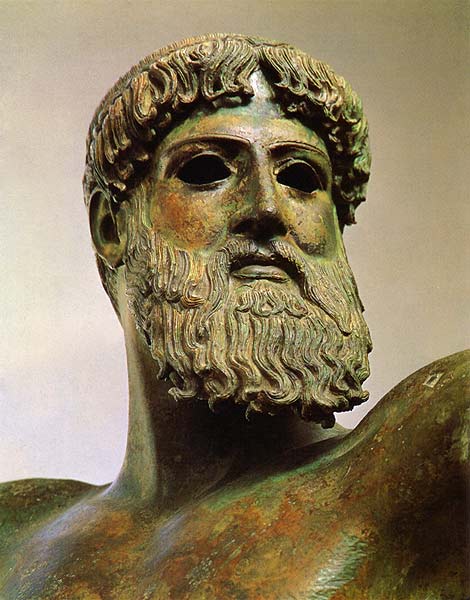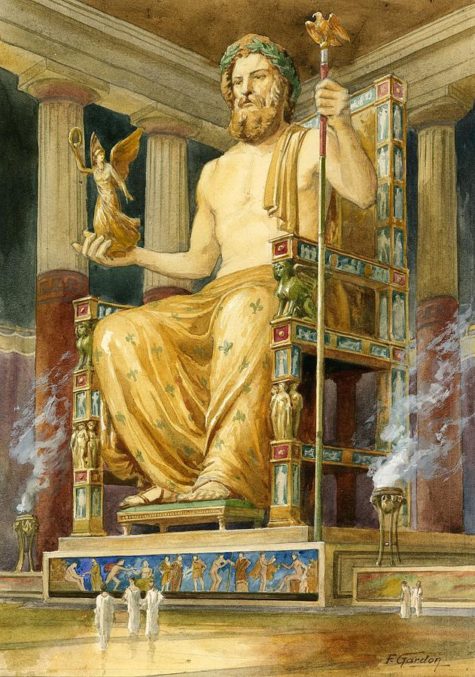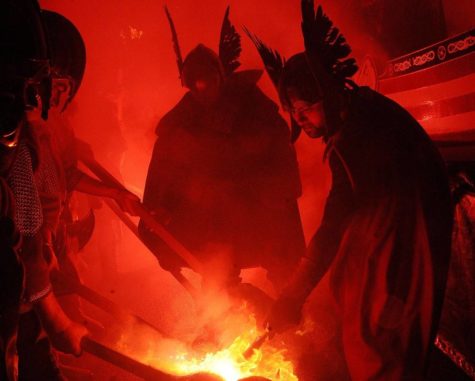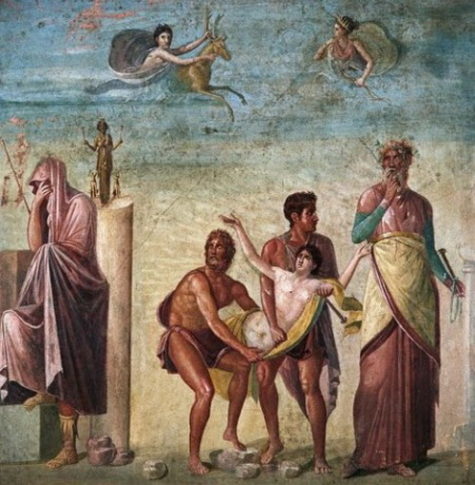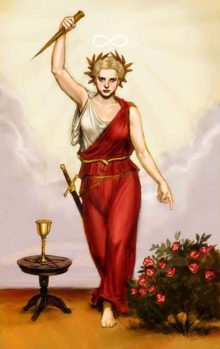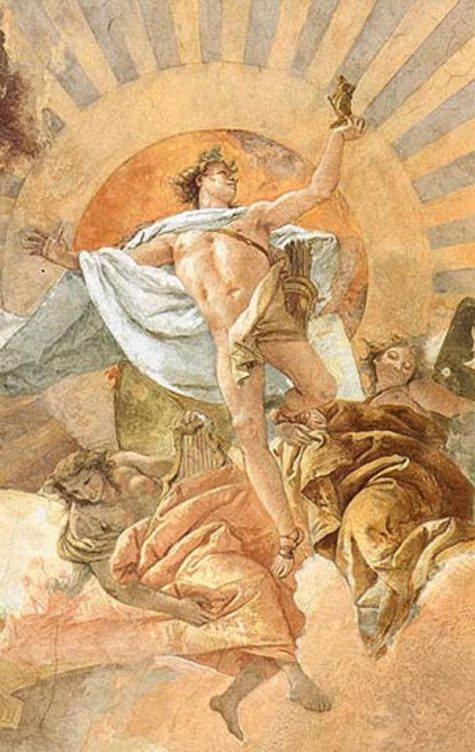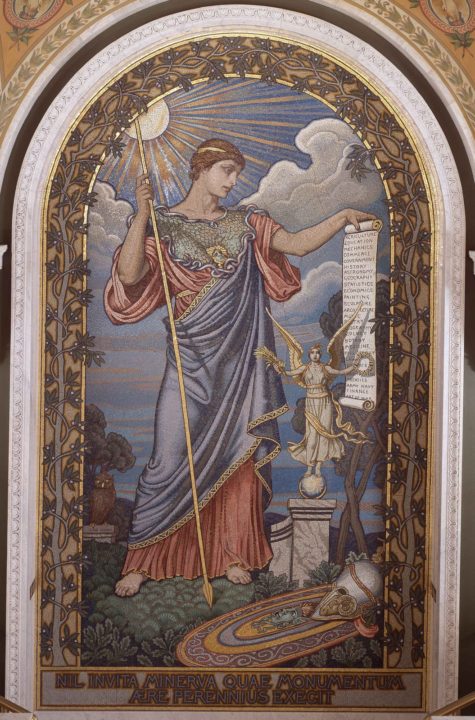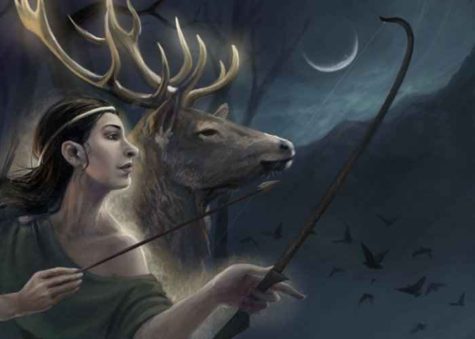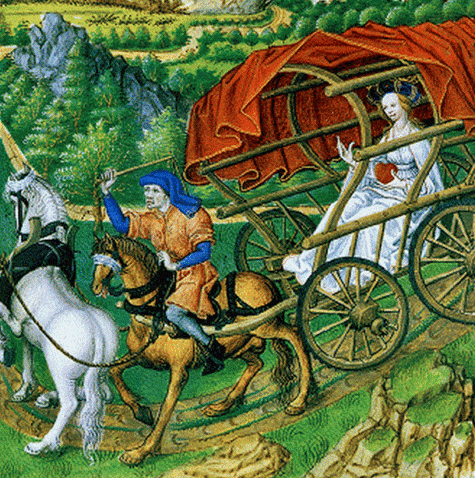Greek Festivals
Light gold-colored candles on your altar and wear oak leaves in your hair to honor the Greek god Zeus, who is traditionally honored on June 12.
The Olympic Games were originally held in honor of Zeus, the king of the Greek gods, and a sacrifice of 100 oxen was made to the god on the middle day of the festival. According to legend, the altar of Zeus stood on a spot struck by a thunderbolt, which had been hurled by the god from his throne high atop Mount Olympus, where the gods assembled.
These Games were held every four years. This four-year period acquired the name “Olympiad”, and was used as a date system: time was counted in Olympiads, rather than years.
Athletes prayed to the gods for victory, and made gifts of animals, produce, or small cakes, in thanks for their successes.
Over time, the Games flourished, and Olympia became a central site for the worship of Zeus. Individuals and communities donated buildings, statues, altars and other dedications to the god. The most spectacular sight at Olympia was the gold and ivory cult statue of Zeus enthroned, which was made by the sculptor Pheidias and placed inside the temple.
The statue was one of the Seven Wonders of the Ancient World, and stood over 42 feet high. A spiral staircase took visitors to an upper floor of the temple, for a better view of the statue.
People who were not Greek could not compete in the Games, but Greek athletes traveled hundreds of miles, from colonies of the Greek city-states. These colonies were as far away as modern-day Spain, Italy, Libya, Egypt, Ukraine, and Turkey.
After the 2nd century A.D., the Roman empire brought even more competitors to the Olympic Games, but regional differences always gave the Olympics an international flavor.
At the outbreak of the Peloponnesian War, the Athenians allowed the founding of a sanctuary for the Goddess Bendis and shortly afterward created a state festival, the Bendideia, for her.The first celebration was held on the 19th of Thargelion (May–June), 429 BC, at the Piraeus, the seaport of Athens.
Many pagan calendars list June 6th as the modern equivalent date for this festival honoring the Moon Goddess of Thrace. Other sources give that her festivals were held on the full moon preceding or coinciding with the solstice – and if so, the dates would vary from year to year.
For a description of the festival we have this excerpt of a conversation between Socrates and a friend describing that festival (from Plato’s Republic):
Sokrates: “I went down yesterday to the Peiraios (Piraeus) with Glaukon (Glaucon), the son of Ariston, to pay my devotions to the Goddess [Bendis], and also because I wished to see how they would conduct the festival since this was its inauguration. I thought the procession of the citizens very fine, but it was no better than the show, made by the marching of the Thrakian contingent [i.e. the mercenary force who policed ancient Athens]. After we had said our prayers and seen the spectacle we were starting for town . . . “
‘Do you mean to say,’ interposed Adeimantus, ‘that you haven’t heard that there is to be a torchlight race this evening on horseback in honor of the Goddess?’
‘On horseback?’ said I. ‘That is a new idea. Will they carry torches and pass them along to one another as they race with the horses, or how do you mean?’
‘That’s the way of it,’ said Polemarkhos, ‘and, besides, there is to be a night festival which will be worth seeing. For after dinner we will get up and go out and see the sights and meet a lot of the lads there and have good talk . . . Let this complete your entertainment, Sokrates, at the festival of Bendis.’
Thargelia (Greek Θαργήλια) was one of the chief Athenian festivals in honour of the Delian Apollo and Artemis, held on their birthdays, the 6th and 7th of the month Thargelion (about May 24 and May 25).
Essentially an agricultural festival, the Thargelia included a purifying and expiatory ceremony. While the people offered the first-fruits of the earth to the god in token of thankfulness, it was at the same time necessary to propitiate him, lest he might ruin the harvest by excessive heat, possibly accompanied by pestilence. The purificatory preceded the thanksgiving service.
The most important ritual was the following. Two men, the ugliest that could be found (the Pharmakoi) were chosen to die, one for the men, the other (according to some, a woman) for the women. Acting as scapegoats for community guilt, they were draped in figs and led through the city. before being cast out.
Hipponax of Kolophon claims that on the day of the sacrifice they were led round with strings of figs on their necks, and whipped on the genitals with rods of figwood and squills. When they reached the place of sacrifice on the shore, they were stoned to death, their bodies burnt, and the ashes thrown into the sea (or over the land, to act as a fertilizing influence). However, it is unclear how accurate Hipponax’s sixth-century, poetical account of the ceremony is, and there is much scholarly debate as to its reliability.
On the first day of the festival, a sheep was sacrificed to Demeter Chloe on the Acropolis, and perhaps a swine to the Fates, but it is generally agreed that an actual human sacrifice took place on this occasion, replaced in later times by a milder form of expiation. Thus at Leucas a criminal was annually thrown from a rock into the sea as a scapegoat: but his fall was checked by live birds and feathers attached to his person, and men watched below in small boats, who caught him and escorted him beyond the boundary of the city. Similarly, at Massilia, on the occasion of some heavy calamity (plague or famine), one of the poorest inhabitants volunteered as a scapegoat. For a year he was fed up at the public expense, then clothed in sacred garments, led through the city amidst execrations, and cast out beyond the boundaries.
After having rid the city of any ill influences on the first day of the festival, the second day begins with a joyous attitude. It follows the basic structure of any other Hellenic festival. First, there was a procession, which included children who carried the eiresione, an olive branch decorated with woolen fillets, bread, fruits, small flasks of honey, and some with oil. The children would sing the following while carrying this:
“The Eiresione brings figs and fat bread,
honey in pots, and oil to rub down,
a cup of strong wine so you go drunk to bed.”
As they moved through the city, they would collect offerings along the way. Once arriving at the temple, the offering of the first fruits of the grain harvest would begin. From the surviving texts we learn that the offering was of two types: a boiled stew of grains and seasonal vegetables, or the loaf of grain bread called the thargelos. It is from the name of the loaf that the festival takes its name. This loaf was also called eueteria, meaning “good year.”
There would also be libations, hymns, much feasting and other activities during the celebration. Singing competitions were especially popular, in which 50 men from the 10 tribes of Athens participated. All of these were done in honor of Apollo, god of purification.
For a more modern approach, we have this idea:
- Themes: Cleansing; Offering; Forgiveness; Magic
- Symbols: Ritual Tools
- Presiding Goddess: As the Greek goddess who created all sacred rituals and ceremonies, Hosia oversees this rite and directs your magical energy toward successful manifestation.
To do Today:
Follow Greek tradition and leave Hosia an offering of fruit, bread, or wheat to encourage her assistance. Next consider creating a personal ritual for cleansing or forgiveness. Hosia will guide your hand in choosing words and actions suited to the working. Alternatively, take out your ritual tools and ask for hosia’s blessing on them saying:
Hosia, these are the tools of my hand, heart, and spirit.
They symbolize the elements and the corners of creation.
Today I ask that you empower them for working magic,
and regulate their use for the greatest good.
May they always direct my energy in perfect love and trust.
So be it.
In ancient Greece, a scapegoat (often a criminal) was often identified to bear the sins for an entire community, then either sacrificed or banished into the wilderness. A way to adapt this practice is by designing an image of something you need to banish, then “driving it away” by putting it in the car and leaving it in a remote spot. As you turn away, ask the goddess Hosia to witness the rite and to empower your efforts for positive change.
Sources: Wikipedia and Pagan Pages and 365 Goddess
According to some pagan calendars, May 14 is listed as the Birthday of Apollo. However, according to the mythology, Apollo was born on the seventh day of the month Thargelion. Wikipedia goes on to say that this was according to Delian tradition, and that according to Delphian tradition, it was the seventh day of the month of Bysios. The seventh and twentieth, the days of the new and full moon, were also held sacred to him.
If the exact date is important you you, I’d suggest you take a look at the Wikipedia article on the Attic Calendar which gives the names of the months and their approximate times in the year. For the purposes of simplicity, I would suggest that the 7th day following either the New or Full Moon in May (May 17 in 2017) would fit the criteria and make for a fine day to celebrate the birth of the God of Light Apollo.
Who is Apollo? Here’s a brief profile:
Apollo is the son of Zeus and Leto. His twin sister is Artemis. He is the god of music, playing a golden lyre. The Archer, far shooting with a silver bow. The god of healing who taught man medicine. The god of light. The god of truth, who can not speak a lie.
One of Apollo’s more important daily tasks is to harness his chariot with four horses an drive the Sun across the sky. He is famous for his oracle at Delphi. People traveled to it from all over the Greek world to divine the future. His tree was the laurel. The crow his bird. The dolphin his animal.
Source: Wikipedia
From May 19-28 is the time of the Greek festival of Kallyntaria and Plynteria, a time that is also known as a time for “spring cleaning”. Most of us have already started our spring cleaning in various forms, but this particular time of the Sacred Year is dedicated to spiritual cleaning – the cleaning and nurturance of the sacred places.
The Greeks were good at that, and they called this festival Kallyntaria and Plynteria, by which they meant making a special effort to clean the sacred statues of the goddess and god. With all that incense burning and dust gathering, the sacred images get pretty dirty, and you had to take them to be washed in the nearest rivers or lakes, submerging them and letting them reunite with the life-giving waters. Afterward, the women dressed the goddess in her jewels, with much ceremony, and paraded her proudly back to her home in the temple. No singing or fun was allowed during this procedures. These festivals were solomnized because it was work, not play.
The same principle applies to us today. Let’s get those brooms out, and wash the house from top to bottom, really giving it an old fashioned purification. What could be more natural than to transform the old custom of spring cleaning into a religious devotion!
For modern Pagans/Wiccans, now is the time to strip down all the old decorations and adornments of your alter or personal magic space and to do some spring cleaning. If your alter has statues or images of the particular God or Goddess (or both) take them to a local river or stream (if you live near one) and bath the statues in the rushing water. If you are no where near a river, you can use either spring water from bottles, or rushing water from your sink.
If your statues and tools are not made of material safe enough for getting wet, then pass them over pine, frankincense, myrrh, or sandalwood incense. You can also use both water and incense to cleanse your magical wares if you feel it necessary. Clean the dust and and clutter your alter may have accumulated in past celebrations. If you still have Beltane items on your alter, now is the time to remove them and gently store them away for next year.
Celebrate this time of cleaning by partaking of refreshing drinks such as fruit juices like lemonade or limeade. Foods can be on the spicy side, incorporating garlic, onion, and spicy peppers for both purifying and cleansing. Don’t forget to offer some to the Gods :).
From: The Grandmother of Time and Witchbook
March 23 is the fifth day of the Quinquatria. A five day Roman festival to honor Minerva which coincides with the five day Ancient Greek festival to honor Athena – her Greek counterpart. Here is a ritual designed for group participation. It can, however, be modified for the solitary practitioner.
- Colors: Blue and brown
- Elements: Air and earth
- Altar: Upon a brown cloth light five blue candles, incense, and many tools of the crafter.
- Offerings: Make something.
- Daily Meal: Let those whose craft is cooking or baking make what they will as an offering.
Quinquatria Invocation III
Bones and clay of earth,
Flesh of trees and vines,
Thread from plant and animal,
Metal drawn from the ground
And forged in fire,
Our hands are midwives
To these unformed substances,
Given to us by the grace of the Mother,
As She gifts all her children.
We birth creations of beauty
That bring a smile to the eye,
We birth creations of usefulness
Made to be seized and worked day after day,
Fitting easily into the hand
That uses them unthinkingly.
Oh, ye many gods of the sacred touch,
Grant us the power to make manifest
With these our own humble hands.
(All approach the altar and select a tool, and speak their intentions towards it. Tools are then taken outside and laid on the Earth, and the Tool Blessing is said over them. Then, for the rest of the day, craftwork will be done, or things made or repaired.)
Tool Blessing (to be spoken or chanted or sung):
Father Labor, Mother Survival,
All brown gods of work and sweat;
Strong of arm, feet on Earth,
Bless this tool in Earth I set;
Sharp and keen, firm and fine,
Never break and never bend;
Be my strength, aid my skill,
Fill my hand and be my friend.
Found in: Pagan Book of Hours
March 21 is the third day of the Quinquatria. A five day Roman festival to honor Minerva which coincides with the five day Ancient Greek festival to honor Athena – her Greek counterpart. Here is a ritual designed for group participation. It can, however, be modified for the solitary practitioner.
- Color: Blue
- Element: Air
- Altar: Upon a blue cloth lay many musical instruments, blue candles, a clear glass bowl of water, and a fan made from a bird’s wing.
- Offerings: Song and music.
- Daily Meal: Light vegetarian meal.
Quinquatria Invocation II
(to be sung)
Hail Athena, true and bright,
Sharp your blade and keen your sight,
Goddess of a Thousand Works,
Giver of the soul in flight.
Guide our touch as we reach out,
Weaver, crafter, artisan,
Guide our urge to build and make,
Guide the power of our hands.
Mentor, teacher, patient tutor,
Maker of heroes through the years
In the epic glance of history,
Giving sight to blinded seers,
Giving purpose to the wanderer,
Giving courage to the weak,
We beseech you, armored Lady,
By the Word of Power you speak,
Like the wind that blows so cold
And bright and clear through minds of grey,
Stand beside us when we falter,
Sweep our weakness clean away.
(The rest of the day should be spent in song, whatsoever has been chosen by the community as the absolute best that they can do, as an offering. Songs can be solo offerings, or as a group. Those who wish to give private offerings can play instrumental music after the main group has left.)
Found in: Pagan Book of Hours
An ancient Greek custom of honoring Artemis’s birthday with a Full Moon cake is still seen today in our birthday cakes. The Greeks even put lighted candles on the Moon cake.
To honor the birthday of the goddess Artemis, bake or buy a small cake or cupcake. In Moon Magick, D J Conway recommends this ritual be performed on the night of the March crescent – it feels more appropriate to me to do the ritual on the night before or the night of her actual day.
Dress in nice clothes as if you were entertaining a friend. Cover your altar or spiritual place with a nice cloth. Put the cake with a small candle on it in the middle of the altar. Set pictures or statues of animals around it for decoration. Artemis loves cats of all kinds, deer, and all wild animals. Set a glass of juice or wine next to the cake.
Take a sip of juice and light the candle. Sing “Happy Birthday” to the goddess if you wish – or simply and sincerely wish her a happy birthday. Then say:
Lady of Wild Things, Moon Huntress,
Mistress of magick and enchantment,
I chant your lovely name for protection.
Artemis! Artemis! Artemis!
I whisper your praises to the Full Moon.
Cradle my restless, worn spirit
In the secret places of your deep woodlands.
Renew my life, swift Artemis.
Cut yourself a piece of the cake and eat it. Drink the juice. Tell the goddess why you need protection. When you are finished, thank her for the help that will come. Put the remainder of the cake outside as a feast for the birds and animals.
Note: I think it’s nice to simply honor the gods without necessarily asking for anything in return. A powerful blessing could be as simple as a recitation of her names and titles. For example:
Hail Mistress of the Animals
My heart opens to the Moon Huntress
Blessings to She of the Wild
Love to the Most Beautiful
Praise to the Lady of Many Shrines and Many Cities
I Worship the Lady of the Wild Mountains
Adoration to the Opener of the Womb
Gratitude to the Mistress of Magic and Enchantment
Artemis! Artemis! Artemis!
For maximum effect – repeat each line three times.
Another note: This ritual can be tweaked for use for any god or goddess on his/her day. Simply find an appropriate invocation – or rewrite the one above to fit, and decorate the altar with whatever might please your chosen deity.
Sources: This post was put together by Shirley Twofeathers for Gypsy Magic, and was moved to its new home here at shirleytwofeathers.com you may repost and share without karmic repercussions only if you give me credit and a link back to this website. Blessed be.
This is the name given to two festivals held in ancient Boeotia, which was a part of Greece, in honor of the reconciliation of Hera and Zeus. The dates of these festivals are somewhat nebulous and varied from place to place and year to year. One source cites March 10th.
The story:
According to the myth, Hera and Zeus quarreled and Hera went away to Euboea and refused to return to his bed. To trick her into coming back and on the advice of Cithaeron, Zeus dressed up a carved oak-trunk to resemble a bride and let it be known that he planned to marry Plataea, the daughter of Asopus. Hera was so angry she tore the clothes from the statue, discovered the deception, and was so pleased that the two were reconciled.
The festivities:
The Lesser Daedala (Δαίδαλα μικρά) was held every four to six years. The people of Plataea went to an ancient oak grove and exposed pieces of cooked meat to ravens, attentively watching upon which tree any of the birds, after taking a piece of meat, would settle. Out of this tree they carved an image, and having it dressed as a bride, they set it on a bullock cart with a bridesmaid beside it. The image seems then to have been drawn to the bank of the river Asopus and back to the town, attended by a cheering crowd.
After fourteen of these cycles (approx.59 or 60 years), the Greater Daedala (Δαίδαλα μεγάλα) was held, and all Boeotia joined in the celebration. At its start one wooden figure was chosen from the many that had accumulated through the years and designated the “bride”. The wooden figure was prepared as a bride for a wedding, ritually bathed in the Asopus, adorned and raised on a wagon with an attendant. This wagon led a procession of wains carrying the accumulated daedala (all the other images that had been created over the years) up to the summit of Mount Kithairon, where a wooden sacrificial altar was erected out of square pieces of wood.
This was covered with a quantity of dry wood, and the towns, persons of rank, and other wealthy individuals, offered each a heifer to Hera and a bull to Zeus with plenty of wine and incense, while at the same time all of the daedala were placed upon the altar. For those who did not possess sufficient means, it was customary to offer small sheep, but all these offerings were immolated in a hecatomb in the same manner as those of the wealthier persons. The fire consumed both offerings and altar
An ancient account of myth behind the festival is related by Pausanias:
“Hera, they say, was for some reason or other angry with Zeus, and had retreated to Euboia. Zeus, failing to make her change her mind, visited Kithairon, at that time despot in Plataea, who surpassed all men for his cleverness. So he ordered Zeus to make an image of wood, and to carry it, wrapped up, in a bullock wagon, and to say that he was celebrating his marriage with Plataia, the daughter of Asopus. So Zeus followed the advice of Kithairon.
Hera heard the news at once, and at once appeared on the scene. But when she came near the wagon and tore away the dress from the image, she was pleased at the deceit, on finding it a wooden image and not a bride, and was reconciled to Zeus. To commemorate this reconciliation they celebrate a festival called Daidala, because the men of old time gave the name of daidala to wooden images… the Plataeans hold the festival of the Daidala every six years, according to the local guide, but really at a shorter interval.
I wanted very much to calculate exactly the interval between one Daedala and the next, but I was unable to do so. In this way they celebrate the feast.”
Found at Wikipedia
The last day of each of the lunar months is the sacred day of the triple goddess of crossroads and the patroness of Witches, Hekate.
Hekate had many names and titles: Hecate Trevia, “of the three ways”; Hecate Phosphoros, “the light bringer”; Hecate Nykterian “of the night”; and Hecate Basileia, “Hecate Queen.” On this night of the waning Moon we have a perfect opportunity to work with this goddess and ask for her blessing to illuminate our darkest times, and grant us her protection.
Hecate, goddess of the crossroads, hear my cry,
Protect and guard me under your midnight sky.
Hecate Phosphoros “she who brings the light,”
Hecate Trevia bless me with your wisdom tonight.
Hekate’s ancient devotees held dinners in her honor, known as Hekate Suppers. Once upon a time, these dinners were consumed outside under the dark moon, ideally at a crossroads. One plate was reserved for Hekate; after her devotees dined, just before they departed, Hekate’s plate was laid down at the crossroads.
Foods associated with her were prepared. The entree was usually fish, especially red mullet. Devotees feasted and celebrated. Offerings and leftovers were placed outside the door or at a crossroads for Hekate and her hounds.
Even way back when, cynics scoffed that food placed outside was actually consumed by feral dogs and homeless people without realizing that this is Hekate’s intent: this is one way she accepts offerings. (The Church was still trying to eradicate this ritual as late as the eleventh century.)
A typical Hekate Supper menu includes eggs, fish roe, goat and sheep cheese, sprats, red mullet – a scavenger fish that was the subject of many taboos – garlic, mushrooms, and honey cake surrounded by blazing torches or cakes decorated with miniature imitation torches (candles). Other ideas include garlic, salmon, honey, and edible flowers.
Traditionally whatever is given to Hekate cannot be reclaimed. Thus, do not break out your priceless set of china; lay the meal on the ground or use a serving dish that will be incorporated into the offering. Once the offering is laid down, depart without looking back. Hekate determines who picks up the offering.
Smaller, private offerings may be left at a crossroads, too:
- Place offerings on a plate or flat stone and leave them at a crossroads after dark.
- Make your invocation and then walk away without looking back.
- Do not return for the plate, or any part of the offering, but consider it part of your gift.
Offerings can include the following:
- Eggs
- Garlic and honey (especially lavender honey)
- Croissants and crescent shaped breads and pastries
- Candles
- Incense
- Images of dogs, especially black dogs
- Actions on behalf of dogs
Encountering or hearing a dog is an indication that your petition has been heard.
Other nights sacred to Hekate:
- Friday the 13th – particularly if it falls in the month of August.
- November 16th is Hekate Night
- August 13th, in Italy, a festival is shared between Diana and Hekate
Sources:
- Invocation by Ellen Dugan
- The Powers That Be
